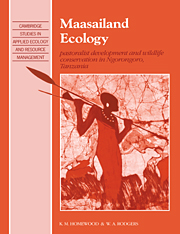Book contents
- Frontmatter
- Contents
- Preface
- 1 Management problems and applied ecology in Ngorongoro Conservation Area
- 2 Ngorongoro Conservation Area
- 3 Maasai of Ngorongoro
- 4 History, politics and perceptions in Ngorongoro
- 5 Management-oriented research in NCA
- 6 Range resources
- 7 Wildlife
- 8 Livestock ecology
- 9 Livestock and wildlife
- 10 Maasai ecology: development, demography and subsistence
- 11 Wildlife conservation and pastoralist development
- 12 Development interventions
- 13 Viewpoint
- References
- Author index
- Subject index
- Map: Ngorongoro Conservation Area, showing the main features and place names used in the text
7 - Wildlife
Published online by Cambridge University Press: 08 February 2010
- Frontmatter
- Contents
- Preface
- 1 Management problems and applied ecology in Ngorongoro Conservation Area
- 2 Ngorongoro Conservation Area
- 3 Maasai of Ngorongoro
- 4 History, politics and perceptions in Ngorongoro
- 5 Management-oriented research in NCA
- 6 Range resources
- 7 Wildlife
- 8 Livestock ecology
- 9 Livestock and wildlife
- 10 Maasai ecology: development, demography and subsistence
- 11 Wildlife conservation and pastoralist development
- 12 Development interventions
- 13 Viewpoint
- References
- Author index
- Subject index
- Map: Ngorongoro Conservation Area, showing the main features and place names used in the text
Summary
Metii oidipa oldoinyo ake oidipa otunokine ewueji nemedotunye.
It is only the mountains which do not move from their places.
(Animals, plants and people all migrate or change – Maasai saying: Mol 1978)Bitir akenya
“The morning is like a warthog’
(It is unpredictable – Maasai saying:Kipury 1983)So much has been written on the wildlife of the Ngorongoro and Serengeti ecosystems that we do not attempt to summarise it all here. Instead this chapter concentrates on the main patterns in the wildlife community, and on management themes. The term ‘wildlife’ has changed over the past few decades, from meaning large game animals worthy of sport hunting, to to the present connotation of whole communities of wild plants and animals linked by intricate patterns of ecological interdependence. The main features of these communities were outlined for NCA in chapter 2, and factors governing the plant resources were discussed in chapter 5. In this chapter we introduce the main animal components, and outline the major natural processes governing the interactions and dynamics of the wild animal populations of NCA – migration, competition, disease, predation and plant–herbivore interactions. We then go on to select specific management issues: wildlife management goals; the concept of naturalness and the extent and desirability of change; species and areas of particular conservation importance; subsistence hunting and ivory poaching.
- Type
- Chapter
- Information
- Maasailand EcologyPastoralist Development and Wildlife Conservation in Ngorongoro, Tanzania, pp. 119 - 140Publisher: Cambridge University PressPrint publication year: 1991



